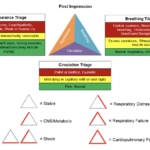In the U.S., approximately 16,000 children have out-of-hospital cardiac arrest each year. The majority of these instances happen due to asphyxiations, including choking, drowning and sudden infant death syndrome. CPR is a quick and safe means of preventing death from cardiac arrest.
Child and infant CPR have some similarities, but there are also distinct differences. Consider the anatomy of a child’s airway and neck when performing rescue breathing. In infants, rescue breathing and chest compressions must both be adapted.
The steps to CPR can be remembered as easily as the ABCs – Airway, Breathing, Circulation and Defibrillation. Airway refers to the manner in which mouth-to-mouth is given to a child. In the case of infants, the rescuer’s mouth must cover both the baby’s mouth and nose in a tight seal.
Breathing refers to the method of keeping oxygen flowing to a child’s lungs. Breaths given in infant CPR are “puffs” of air as if blowing the air from your cheeks.
Circulation refers to keeping the blood flowing. In a child, the heel of one hand is used during compressions. In an infant, only two fingers are used to perform compressions just below the nipple line.
Contact SureFire CPR to learn more about Pediatric Emergency Assessment, Recognition, Stabilization (PEARS) and CPR.










